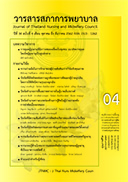Factors Influencing the Accuracy of Emergency Severity Index-Based Emergency Patient Triage
Keywords:
accuracy of emergency patient triage, emergency patients, Emergency Severity Index, triage nurses, training programme, patients’ age, comorbidity, emergency department experienceAbstract
Objective: To study how emergency department nurses’ experience and training, and patients’ age and comorbidity status, could influence the accuracy of emergency patient triage based on the Emergency Severity Index.
Design: Predictive correlational research.
Methodology: The participants were 78 triage nurses and 780 emergency patients at the emergency departments of seven tertiary hospitals affliated to the Ministry of Public Health and located in Bangkok Metropolitan Region. Five instruments were used to collect data: 1) a questionnaire on the triage nurses’ demographic data; 2) a questionnaire on the patients’ demographic data; 3) the Comorbidity Index by Charlson et al; 4) an outcome accuracy index; and 5) the Emergency Severity Index, version 4. Data were analysed using descriptive statistics and multinomial logistic regression analysis.
Results: The emergency nurses were found to perform emergency patient triage with 68.7% accuracy. Instances of overtriage were less frequently detected amongst nurses with 6 to 10 or more years of emergency department experience than amongst those with 1 to 5 years of emergency department experience (p < 0.01). Similarly, instances of undertriage were less frequent amongst nurses with 6 to 10 years of emergency department experience than amongst those with 1 to 5 years of emergency department experience (p < 0.01). In addition, undertriage was more frequent amongst the nurses who had passed a triage training programme than amongst those who had not (p < 0.01). The patients aged more
than 65 years were 2.43 times more likely to be undertriaged than those aged between 18 and
54 years (p < 0.05). Comorbidity, on the other hand, was not found to influence the accuracy of emergency patient triage based on the Emergency Severity Index.
Recommendations: Nurses appointed to the triage system should possess a minimum of 5 years’ emergency department experience and pass a standardised triage training programme, so as to minimise triage errors. Patients aged over 65 years need to be classifed according to medical procedure, and constantly monitored.
Downloads
References
operational information for commissioning (Central); 2017.
2. Sirisamitr T, Wachiradilok P. Annual report 2016 National Institute for Emergency Medicine. Bangkok:
Ultimate Printing; 2017. (in Thai)
3. UCEP coordination center, National Institute for Emergency Medicine. Universal coverage for emergency
patients: UCEP 2018 [cite 2018 March 7]. Available from: https://www.niems.go.th/th/Upload/File/256104091000232914_EtLeXFtU5mKNUd49. pdf. (In Thai)
4. Somma DS, Paladino L, Vaughan L, Lalle I, Magrini L, Magnanti M. Overcrowding in emergency department:
an international issue. Intern Emerg Med. 2015;10(2):171-5.
5. Wachiradilok P, Sirisamutr T, Chaiyasit S, Sethasathien A. A nationwide survey of Thailand emergency departments
triage systems. TJNC 2559;31(2):96-108. (In Thai)
6. Gilboy N, Tanabe P, Travers D, Rosenau AM. Emergency Severity Index (ESI): a triage tool for emergency
department care, version 4. implementation handbook, 2012 edition: Rockville, MD: Agency for Healthcare
Research and Quality; 2011.
7. Richardson DB. Increase in patient mortality at 10 days associated with emergency department overcrowding.
Med J Australia. 2006;184(5):213-6.
8. Sittichanbuncha Y. Triage. In: Yuksen C and Sittichanbuncha Y, editors. ER RAMA. Bangkok: Vista interprint; 2011.
(in Thai)
9. Fathoni M, Sangchan H, Songwathana P. Relationships between triage knowledge, training, working experiences
and triage skills among emergency nurses in East Java, Indonesia. Nurse Media Journal of Nursing 2013;
3(1):511-25.
10. Soontorn T, Sitthimongkol Y, Thosingha O, Viwatwongkasem C. Factors influencing the accuracy of triage by registered nurses in trauma patients. Pacifc Rim Int J Nurs Res 2018; 22(2):120-30.
11. Nakahara S, Matsuoka T, Ueno M, Mizushima Y,Ichikawa M, Yokota J, et al. Predictive factors for
undertriage among severe blunt trauma patients: what enables them to slip through an established trauma
triage protocol? J Trauma 2010;68(5):1044-51.
12. Platts‐Mills TF, Travers D, Biese K, McCall B, Kizer S,LaMantia M, et al. Accuracy of the Emergency Severity
Index triage instrument for identifying elder emergency department patients receiving an immediate life-saving
intervention. Acad Emerg Med 2010;17(3):238-43.47
13. Cox S, Morrison C, Cameron P, Smith K. Advancing age and trauma: triage destination compliance and
mortality in Victoria, Australia. Injury 2014;45(9): 1312-29.
14. Hinson J, Martinez D, Schmitz P, Toerper M, Radu D, Scheulen J, et al. Accuracy of emergency department triage
using the Emergency Severity Index and independent predictors of under-triage and over-triage in Brazil:
a retrospective cohort analysis. Int J Emerg Med 2018;11(1):1-10.
15. Barnett K, Mercer SW, Norbury M, Watt G, Wyke S, Guthrie B. Epidemiology of multimorbidity and
implications for health care, research, and medical education: a cross-sectional study. Lancet 2012;
380(9836):37-43.
16. Xiang H, Wheeler KK, Groner JI, Shi J, Haley KJ. Undertriage of major trauma patients in the US emergency
departments. Am J Emerg Med 2014;32(9):997-1004.
17. Benjamin ER, Khor D, Cho J, Biswas S, Inaba K, Demetriades D. The age of undertriage: current
trauma triage criteria underestimate the role of age and comorbidities in early mortality. J Emerg Med.
2018;55(2):278-87.
18. Ahmad R, Cherry RA, Lendel I, Mauger DT, Service SL, Texter LJ, et al. Increased hospital morbidity
among trauma patients with diabetes mellitus compared with age- and injury severity score-matched control
subjects. Archives of Surgery 2007;142(7):613-8.
19. Donabedian A. The quality of care. How can it be assessed? JAMA 1988;260(12):1743-8.
20. Chen SS, Chen JC, Ng CJ, Chen PL, Lee PH, Chang WY. Factors that influence the accuracy of triage
nurses’ judgement in emergency departments. Emer Med J 2010;27(6):451-5.
21. Charlson ME, Charlson RE, Peterson JC, Marinopoulos SS, Briggs WM, Hollenberg JP. The Charlson Comorbidity
Index is adapted to predict costs of chronic disease in primary care patients. J Clin Epidemiol 2008;61(12):
1234-40.
22. Durand AC, Gentile S, Gerbeaux P, Alazia M, Kiegel P, Luigi S, et al. Be careful with triage in emergency
departments: interobserver agreement on 1,578 patients in France. BMC Emerg Med 2011;11(1):1-10.
23. Pimdee E, Prompinit S, Mitsungnuen T, Pugoen P. Inter-rater reliability of triage patients among outpatient
department, accident and emegency department nurses and emergency physicians in Srinagarind Hospital.
Srinagarind Med J 2015;30(6):587-91. (in Thai)
24. Bergs J, Verelst S, Gillet JB, Vandijck D. Evaluating implementation of the Emergency Severity Index in a Belgian Hospital. J Emerg Nurs 2014;40(6):592-7.
25. Garbez R, Carrieri-Kohlman V, Stotts N, Chan G, Neighbor M. Factors influencing patient assignment
to level 2 and level 3 within the 5-level ESI triage system. J Emerg Nurs 2011;37(6):526-32.
26. Vibulwong P, Rittiwong T. A competency evaluation of participants from the emergency nurse training
program at Boromarajonani Collage of Nursing, Bangkok. Journal of Boromarajonani Collage of
Nursing, Bangkok 2014;30(1):72-85. (in Thai)
27. Navaratnarajah A, Jackson SH. The physiology of ageing. Medicine 2013;41(1):5-8.
28. Justiniano CF, Evans DC, Cook CH, Eiferman DS, Gerlach AT, Beery Ii PR, et al. Comorbiditypolypharmacy score: a novel adjunct in post–emergency department trauma triage. J Surg Res 2013;181(1): 16-9.








